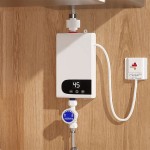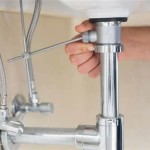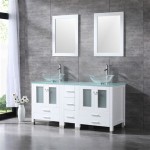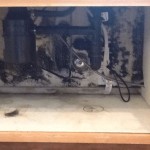Small Flies in Bathroom Sink: Identification, Causes, and Control
The persistent appearance of small flies in the bathroom sink is a common household problem. These tiny insects, often mistaken for fruit flies, can be a nuisance and a sign of underlying issues within the plumbing system and bathroom environment. Understanding the specific type of fly, identifying the source of the infestation, and implementing appropriate control measures are crucial steps in eradicating these pests and preventing their return.
Identifying the Culprit: Drain Flies vs. Fruit Flies
Accurate identification of the fly species is essential for effective treatment. The most common culprits found in bathroom sinks are drain flies (also known as moth flies or sewer flies) and fruit flies. While both are small and can be found in similar environments, there are distinct differences in their appearance and behavior.
Drain Flies: These flies are typically dark in color, ranging from gray to black. They have a fuzzy appearance due to the numerous hairs covering their body and wings. Their wings are relatively large in proportion to their body and are held roof-like over their abdomen when at rest, giving them a moth-like appearance. Drain flies are weak fliers and tend to hop or flutter short distances. They are often found near drains, sinks, and other areas where stagnant water accumulates.
Fruit Flies: Fruit flies are usually smaller than drain flies and have a reddish-brown color. They have smooth bodies and clear wings. Fruit flies are attracted to overripe fruits, vegetables, and other fermenting organic matter. While they can be found in bathrooms, they are more commonly associated with kitchens and areas where food is present.
Distinguishing between these two types of flies is important because their breeding grounds and control methods differ. Drain flies breed in the organic matter that accumulates in drains, while fruit flies breed on decaying fruit and vegetables.
Understanding the Sources of Infestation
The presence of small flies in the bathroom sink generally indicates a readily available food source and a suitable breeding environment. Identifying and eliminating these sources is paramount to controlling the infestation.
Drain Flies and Organic Matter: Drain flies thrive in the decaying organic matter that accumulates within drainpipes. This organic matter, which can consist of hair, soap scum, food particles, and other debris, provides a rich food source for the fly larvae. The moist and dark environment within the drain is ideal for their development. Leaky pipes, slow-draining sinks, and infrequently used drains are particularly susceptible to drain fly infestations.
Fruit Flies and Fermenting Material: While less common in bathrooms, fruit flies can be attracted to fermenting substances such as spilled drinks, lotions, or improperly disposed of hygiene products. Even small amounts of these materials can provide a breeding ground for fruit flies. Open trash cans or damp towels can also contribute to the problem.
Identifying the Specific Drain: Once you’ve determined the flies are drain flies, identifying the specific drain from which they are originating is crucial. Observe the areas where the flies are most concentrated. Consider placing a piece of clear tape over each drain, sticky-side down, overnight. The presence of flies stuck to the tape in the morning will indicate the source of the infestation. Check all drains in the bathroom, including the sink, shower, and tub drains.
Effective Control and Prevention Strategies
Eradicating small flies from the bathroom sink requires a multi-pronged approach that targets both the adult flies and their breeding grounds. Focusing solely on killing adult flies will only provide temporary relief, as new flies will continue to emerge from the drains.
Cleaning the Drains: The primary step in controlling drain flies is to thoroughly clean the affected drains to remove the organic matter that serves as their food source. Avoid using harsh chemical drain cleaners, as they can be corrosive to pipes and may not effectively eliminate the organic buildup. Instead, consider the following methods:
Mechanical Cleaning: Use a drain snake or plumbing brush to physically remove the accumulated debris from the drainpipe. This is often the most effective method for removing large clumps of hair and soap scum.
Boiling Water: Pouring boiling water down the drain can help to dislodge and flush away some of the organic matter. Exercise caution when using boiling water, especially in older plumbing systems, as it can potentially damage pipes.
Baking Soda and Vinegar: Pour one cup of baking soda down the drain, followed by one cup of vinegar. Let the mixture fizz for 30 minutes, then flush the drain with hot water. This combination can help to break down grease and other organic matter.
Enzyme Cleaners: Enzyme-based drain cleaners contain enzymes that digest organic matter. These cleaners are a more environmentally friendly option than chemical drain cleaners and can be effective at breaking down the food source for drain flies. Follow the instructions on the product label carefully.
Trapping Adult Flies: While cleaning the drains is the most important step, trapping adult flies can help to reduce their population and prevent them from laying more eggs. A simple fruit fly trap can also be effective for drain flies. To create a trap, use a small bowl or jar and fill it with a mixture of apple cider vinegar and a few drops of dish soap. The apple cider vinegar attracts the flies, and the dish soap breaks the surface tension of the liquid, causing them to drown.
Maintaining a Clean Bathroom Environment: Preventing small fly infestations requires maintaining a clean and dry bathroom environment. Regularly clean the sink, shower, and tub to remove soap scum and hair. Wipe up any spills promptly. Empty trash cans frequently. Ensure that drains are properly sealed and that there are no leaks in the plumbing system.
Preventative Measures: To prevent future infestations, flush drains regularly, especially those that are infrequently used. Pouring boiling water down the drains once a week can help to prevent the buildup of organic matter. Consider using a strainer in the sink and shower drains to catch hair and other debris.
Addressing Plumbing Issues: If the problem persists despite regular cleaning and preventative measures, there may be an underlying plumbing issue contributing to the infestation. Leaky pipes or clogged drains can provide a constant source of moisture and organic matter. Consult a qualified plumber to inspect the plumbing system and address any necessary repairs.
Professional Pest Control: In cases of severe infestations or when home remedies prove ineffective, professional pest control services may be necessary. A pest control professional can identify the source of the infestation and implement targeted treatments to eliminate the flies and prevent their return. They may also have access to specialized equipment and products that are not available to the general public. Always ensure the pest control company is licensed and experienced in dealing with drain fly infestations.
Ongoing Monitoring: After implementing control measures, continue to monitor the bathroom for signs of fly activity. If flies reappear, repeat the cleaning and trapping steps as needed. Regular monitoring and maintenance are essential for preventing future infestations.

5 Easy Ways To Get Rid Of Drain Flies Fast

How To Get Rid Of Drain Flies Moth And Prevent An Infestation Pest Defence
Jab Plumbing Solutions Blog Blocked Drain Plumbers

How To Rid Of Drain Flies Forbes Home

How To Get Rid Of Drain Flies

What Are Those Little Dark Colored Flies That Come Out Of My Bathroom Sink Uf Ifas Entomology And Nematology Department

Are These Drain Flies Coming Out Of My Bathroom Drains
We Are Seeing Small Flies In Our Bathroom Any Idea What Could Be Causing Them To Show Up Quora

Identify Tiny Bugs In Bathroom And Get Rid Of Them For Good

Fruit Flies In The Bathroom Get Rid Of Them Michael S Plumbing Orlando







